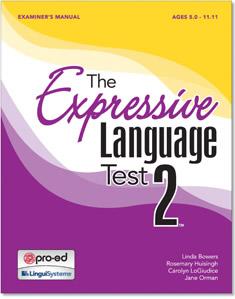
ELT-2: The Expressive Language Test 2
Assess Classroom Language
Testing Time: 30 40 minutes
The Expressive Language Test 2 (ELT 2) measures language expression and flexibility. This assessment is unique in that the language skills tested are those commonly identified by researchers, teachers, and clinicians as most predictive of classroom learning difficulty.
The (ELT 2) is comprised of five subtests with tasks that require students to process and organize language, retrieve what they hear, and use the expressive skills needed for success in the classroom. The test is sensitive to typical variations in expressive language development which means you'll identify those children with true expressive language disorders and have less chance of over-identification.
The sequencing tasks included are a fundamental skill of narrative ability. The inability to sequence and express a narrative is an important predictor of academic success.
The Metalinguistic tasks of Defining and Generating Examples are included in order to tap a student's awareness of and ability to express the meanings of words and to use those words in context. Students with expressive language disorders may not have the vocabulary or know how to exactly zero in on the set of features that belong to a word in order to do well on these tasks.
Grammar and Syntax are areas that consistently define children with expressive language disorders. Deficits in these areas affect a student's ability to communicate meaningfully.
Defining Categories measures a student's ability to give verbal definitions and is well-recognized as a strong correlate of children's academic success and literacy attainment (Chall, 1987; Johnson & Anglin, 1995).
Subtests:
- Subtest A: Sequencing
Sequencing skills are tested in three ways. The student describes a sequence of events or answers sequence questions about a picture in the first task. Next the student is asked to tell about an event without using pictures. The last task asks the student to sequence a set of pictures and tell a story about them. - Subtest B: Metalinguistics Defining and Subtest C: Metalinguistics Generating Examples
These subtests are presented together. The student defines a concept and then gives an example of it. - Subtest D: Grammar and Syntax
These skills are measured in two ways. The student is asked to repair grammar and syntax at the sentence level and then, is asked to put words in the correct order to make a comprehensible sentence. - Subtest E: Defining Categories
The student is asked to define or describe a category when presented with a category name.
COMPLETE TEST INCLUDES: Examiner's Manual, Stimuli Book, 16 Picture Sequence Cards, and 20 Test Forms. (©2010)
User Qualifications:
“All test users, regardless of level and profession, are expected to abide by the standards set forth by the APA, AERA and NCME regarding the ethical use, protection and dissemination of all test materials.
All orders for the products listed below cannot be completed online, they must be placed on official institutional purchase order forms or professional letterhead. For questions or help placing your order for these items call (800) 880-4433.
